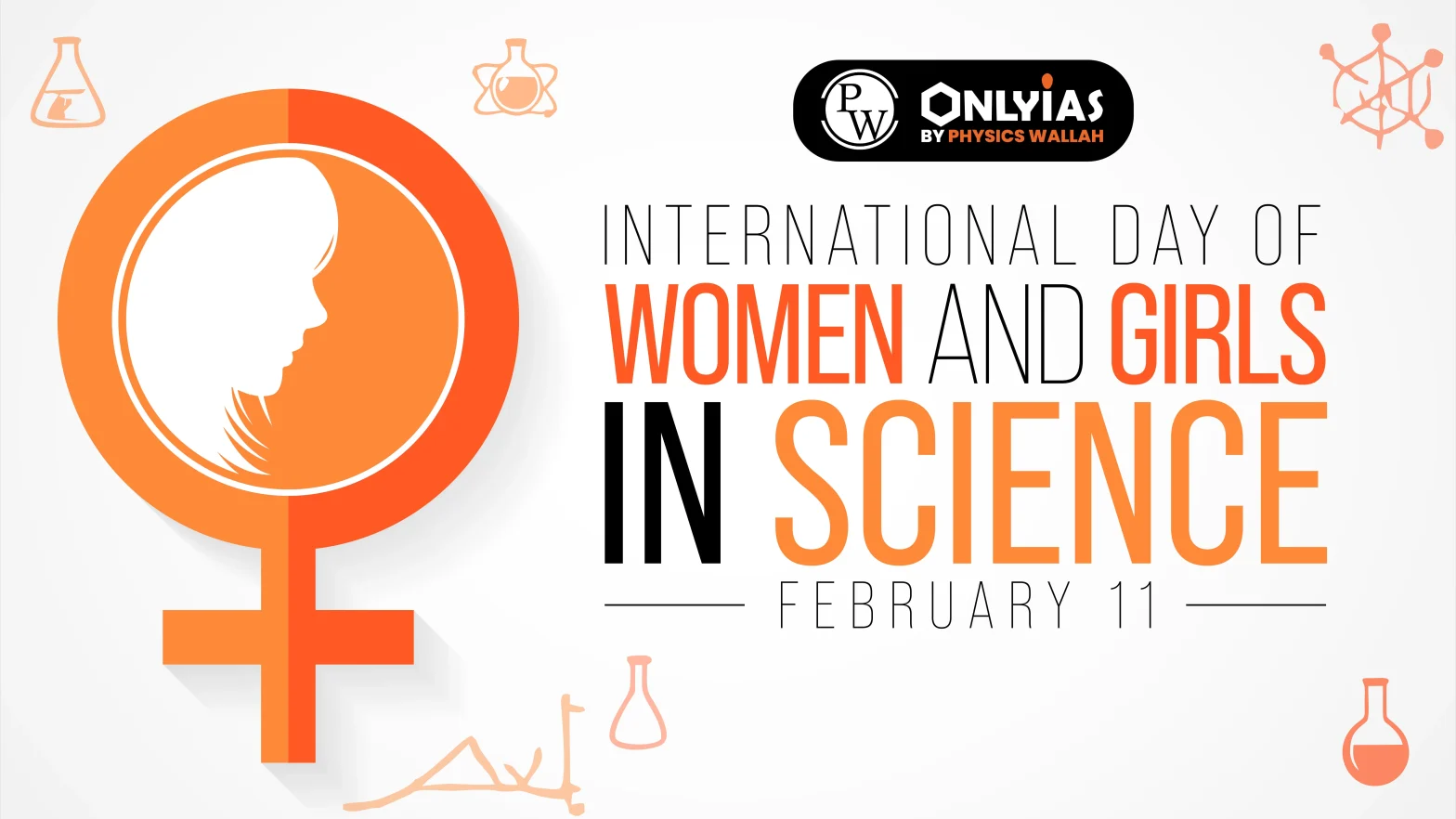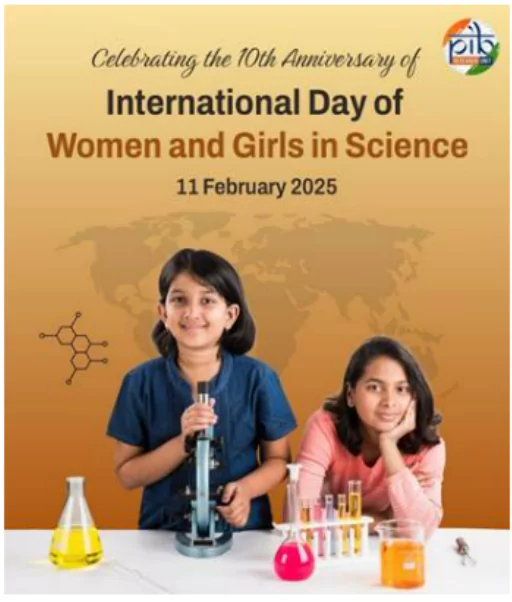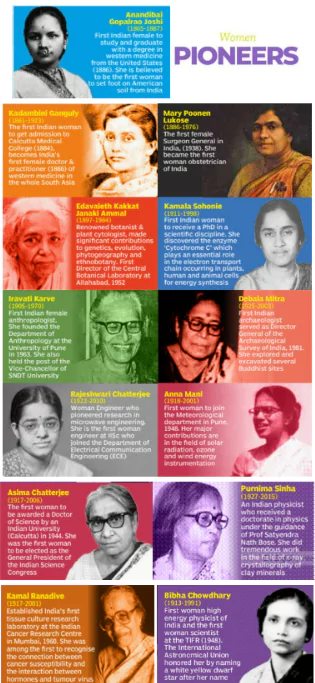International Day of Women and Girls in Science is celebrated on February 11, every year, to commemorate the women’s contribution to science and technology.

International Day of Women and Girls in Science 2025 is observed on February 11, 2025, celebrating a decade of progress. to recognize the contributions of women in science and technology while promoting gender equality in STEM (Science, Technology, Engineering, and Mathematics) fields. This day highlights the importance of encouraging young girls to pursue careers in science and breaking barriers that limit their participation.
Despite remarkable progress, women remain underrepresented in scientific research and technological innovation. Initiatives worldwide, including in India, are focusing on enhancing women’s participation in STEM, and fostering an inclusive and diverse scientific community.

Credits – pib.gov.in
Established by the United Nations General Assembly in 2015, this day aims to encourage young girls to pursue careers in science, address gender disparities, and highlight the achievements of women in technology and research. World celebrated the 10th anniversary of International Day of Women and Girls in Science. Various global and national organizations participate in awareness campaigns, discussions, and STEM-focused programs to foster inclusivity in research and innovation.
| International Day of Women and Girls in Science 2025 Highlights | |
| Aspect | Details |
| Date | February 11, 2025 |
| Theme for 2025 | “Unpacking STEM careers: Her Voice in Science” |
| Established By | United Nations General Assembly (2015) |
| Objective | Promote gender equality in STEM fields and encourage women’s participation in science |
| Key Focus Areas | STEM education for girls, women-led research, gender inclusivity in scientific communities |
| Observed By | United Nations, scientific institutions, governments, and educational organizations worldwide |
The United Nations General Assembly (UNGA) declared February 11 as the International Day of Women and Girls in Science in 2015 to address the gender gap in STEM fields. This initiative aims to promote equal opportunities for women in scientific research, encourage education in science for girls, and highlight the achievements of female scientists worldwide.
The significance of this day includes:
The theme for International Day of Women and Girls in Science 2025 is “Unpacking STEM Careers: Her Voice in Science”. This theme highlights the importance of amplifying women’s voices in STEM fields and ensuring equal opportunities for women and girls in scientific research and technological advancements. The 2025 theme focuses on encouraging more women to pursue careers in STEM by addressing barriers to entry. It promotes gender-inclusive policies in scientific institutions and industries. It encourages mentorship programs and role models to inspire young girls to enter STEM careers.
Women have played a pivotal role in shaping scientific discoveries and technological advancements. From Marie Curie’s pioneering work in radioactivity to Kalpana Chawla’s contributions in space exploration, women have significantly impacted various scientific domains.
Despite these achievements, women still face challenges such as underrepresentation, gender bias, and lack of opportunities in the STEM workforce. Encouraging women’s participation in research and innovation is crucial for sustainable development and technological progress.
| Key Contributions of Women in Science and Technology | ||
| Scientist | Field of Contribution | Notable Achievements |
| Marie Curie | Physics & Chemistry | Discovered radioactivity, Nobel Prize winner |
| Kalpana Chawla | Aerospace Engineering | First Indian woman in space |
| Rosalind Franklin | Molecular Biology | Contributed to DNA structure discovery |
| Kiran Mazumdar-Shaw | Biotechnology | Founder of Biocon, leading biotech innovations |
| Dr. Tessy Thomas | Aerospace Engineering | First woman to lead India’s missile program |
India has a rich legacy of women scientists and engineers who have contributed to various fields, including space exploration, medicine, biotechnology, and physics. The government has launched several initiatives to encourage young girls to pursue science and support women researchers.

Credits – pib.gov.in
| Scientist | Field | Achievements |
| Dr. Janaki Ammal | Botany | Contributions in cytogenetics and plant breeding |
| Dr. Indira Hinduja | Medicine | Developed India’s first test-tube baby |
| Dr. Tessy Thomas | Aerospace | Director of Agni missile project |
| Dr. Ritu Karidhal | Space Science | Deputy Director of Chandrayaan-2 mission |
| Dr. Gagandeep Kang | Virology | Developed vaccines for rotavirus |
To bridge the gender gap, India has implemented several government policies and programs aimed at supporting women scientists and technologists.
India has launched multiple initiatives to empower women in STEM and increase their participation in scientific research and innovation. These initiatives have significantly increased the number of women in STEM fields, but more needs to be done to achieve full gender parity in science and technology.
| Key Initiatives Supporting Women in Science | |
| Initiative | Objective |
| KIRAN (Knowledge Involvement in Research Advancement through Nurturing) | Encourages women in science and research |
| DST Women Scientist Scheme (WOS) | Supports women returning to research after a career break |
| Vigyan Jyoti Program | Encourages girls from rural areas to pursue STEM careers |
| Gender Advancement for Transforming Institutions (GATI) | Aims to create gender-inclusive research environments |
| INSPIRE (Innovation in Science Pursuit for Inspired Research) | Promotes STEM education among young girls |
To create a more inclusive scientific community, several steps must be taken to encourage and support women in STEM:
Ready to boost your UPSC 2025 preparation? Join PW’s UPSC online courses today!
The International Day of Women and Girls in Science is observed on February 11 to promote gender equality in STEM fields and recognize the contributions of women in science and technology.
The theme for International Day of Women and Girls in Science 2025 is Unpacking STEM careers: Her Voice in Science.
Women scientists in India have contributed significantly to fields like space exploration, medicine, biotechnology, and physics, with pioneers such as Dr. Ritu Karidhal, Dr. Tessy Thomas, and Dr. Indira Hinduja leading innovations.
Programs like KIRAN, Vigyan Jyoti, DST Women Scientist Scheme, and INSPIRE aim to increase women's participation in STEM careers by offering scholarships, mentorship, and research opportunities.
Gender equality in science ensures diverse perspectives, increased innovation, and more equitable research outcomes, contributing to global development and technological advancements.

<div class="new-fform">
</div>